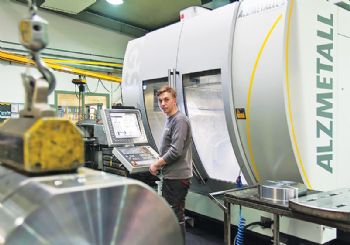
The need for Krenhof AG — an Austrian manufacturer of forgings — to produce an increasing number of modular dies recently resulted in the purchase of two Alzmetall mill-turn centres equipped with Heidenhain TNC 640 controls.
The first five-axis machining centres in the company’s Köflach factory, they were complemented by a new CAM system.
This investment represents a major advance for Krenhof, allowing it to be more flexible in responding to orders — and more reliable in delivering them.
The company has been producing drop forgings for the last 300 years; currently these are in medium to large batches (from 2,000 to 500,000), with the automotive industry its largest customer.
The motor-sport, off-road vehicle, passenger lift and railway sectors are also supplied.
Franz Krammer, tool-making manager at Krenhof, said: “Customers in the automotive industry want the 10,000th forging to look exactly like the first, so quality — as well as price — is increasingly important.
“One factor helping us to maintain high standards is our use of modular carriers with replaceable die inserts, enabling optimum tools to always be used in our forging process to guarantee precision.”
He says the universality of the Heidenhain TNC 640 CNC system (
www.heidenhaingb.com) is also important in enabling Krenhof to achieve top quality standards, “as it controls both milling and turning operations on the machining centres well.”
Behind Krenhof’s progression to five-axis prismatic machining with integrated turning was the need to achieve one-hit die manufacture to enhance accuracy.
The two Alzmetall GS 1200/5-FDT machining centres with the TNC 640 control option were ordered after research into the best machining solution for the company’s operation.
Moreover, Mr Krammer was impressed by the way his team familiarised themselves with the new process after just one week of training.
Need for accuracy
He said: “Small inaccuracies in tool-making lead to large inaccuracies on the finished forged part, so we chose the 20-tonne Alzmetall machine with its quadruple guideways in the linear axes for maximum stability.
Dynamic and precise motion control provided by the TNC 640 CNC allows the machine to realise its full potential.
The control is also convenient to use. Downloading the NC program from the CAM system, for example, is quick and easy via Heidenhain’s TNCremo Windows-based communication software.”
He added that the TNC 640 simplifies the structuring of sub-routines, allowing complex programs to be assembled and run. Moreover, the young Krenhof team had no difficulty programming on the shopfloor, using Heidenhain’s Klartext conversational language.
The operators are particularly keen on the availability of numerous canned cycles, such as those for drilling, which are simply and quickly parameterised.
Mr Krammer also says that machine operation is clear and logical, despite the wide functional range of the control.
“It is particularly easy to combine turning and milling in a single program, with changeover achieved simply by calling up a short subroutine.”
For components requiring multi-sided machining, operators use the Plane function to define an inclined surface above the tilting rotary table.
Programming and machining are then performed in the normal X/Y plane. Probing a reference point on a tilted plane is also simple and is frequently used.
In conclusion, Mr Krammer said: “Entering the realm of five-axis prismatic machining with the added complexity of in-cycle turning was possible for us thanks to the reliability of the available technology.
“It is also helpful that the Heidenhain control has all the necessary functions as standard — and is easy to learn.
“The change in tool-making strategy here has brought with it long-term dimensional accuracy and — above all — reliability in the forging process.”